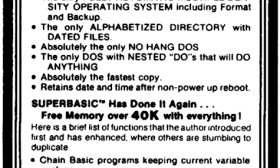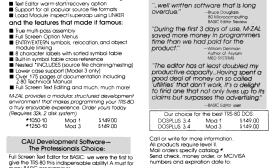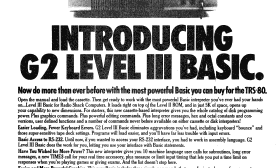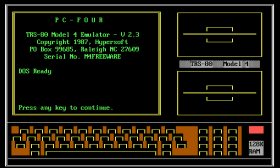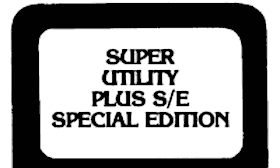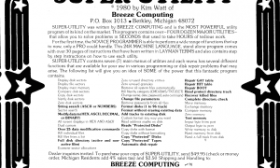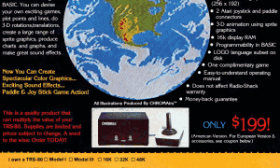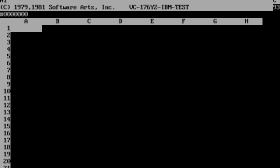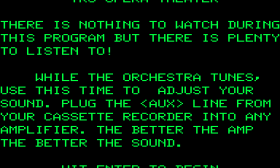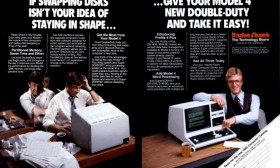Articles in the "Software" Category
MULTIDOS was one of the major TRS-80 operating systems, described in advertisements as “the most compatible, user friendly operating system on the market.” It was written by Vernon Hester, the author of ULTRADOS, and was in some ways a continuation of that operating system. MULTIDOS was the least expensive TRS-80 operating system and also the one with the most recent update (MULTIDOS 5.1 in 2005). It was also the only TRS-80 operating system to offer software compatible versions for the TRS-80 Model I, Model III, Model 4, and the Lobo MAX-80.
ULTRADOS was an earlier TRS-80 operating system for the Model I that was sold by Level IV Products. After Vernon Hester parted ways with Level IV Products in 1981, he began writing a completely new operating system. This operating system, which was briefly advertised as ULTRA-II, soon became known as MULTIDOS. Vernon Hester originally sold MULTIDOS through his company, Cosmopolitan Electronics Corporation. The Model I version of MULTIDOS was released in late 1981 and the Model III version was released in January 1982. The price started out at $79.95 but soon increased to $99.95. Later on, MAX-80 MULTIDOS was released in late 1983 and Model 4 MULTIDOS (originally known as MULTIDOS 80/64) in 1985.
(Read more...)
M-ZAL was a powerful disk-based editor assembler system for the TRS-80 Model I and III. First introduced in 1981, M-ZAL (which stood for Modular Z80 Assembly Language) was written by Jeffrey Krantz and David Willen. It was sold by Computer Applications Unlimited (also known as CUA) for the price of $149.95.
Although expensive, M‑ZAL was one of the most advanced assemblers ever written for the TRS-80 and it was used by many professional TRS-80 developers. The advertisements contained endorsements from several TRS-80 authors, including:
(Read more...)
Level III BASIC was an enhanced version of Level II BASIC for the TRS-80 Model I. It was created by Microsoft, also the authors of Level II BASIC, but sold by GRT Corporation on cassette for $49.95. Level III BASIC was said to be the first consumer product from Microsoft, which had previously sold only to manufacturers.
Rather than sell Level III BASIC directly to consumers, Microsoft decided to release it through GRT Corporation in 1978. GRT Corporation, which stood for Great Records and Tapes, was a music company that had expanded into the software business. The GRT software division, named G2, was started by Vern Raburn and Level III BASIC was sold under the G2 label.
The Level III BASIC manual contains this surprising statement of authorship:
(Read more...)
PC-Four was the first TRS-80 Model 4 emulator for IBM PC compatible computers. It was written by Michael Gingell and introduced by Hypersoft in mid-1987 for a price of $79.95. PC-Four required a computer with at least 384K of memory and worked on both floppy and hard drive systems.
PC-Four (sometimes referred to as PC4) was quite different than later TRS-80 emulators. It achieved most of its compatibility not through Model 4 hardware emulation but by emulating the Model 4 operating system. This approach (similar to the MS-DOS emulator DOSBox today) allowed PC-Four to approximate Model 4 speed when running on a Tandy 1000 SX. The PC-Four manual described it this way:
(Read more...)
In late 1982, PowerSOFT began advertising the “Super Utility Plus Special Edition.” The package, sometimes referred to as “Super Utility Plus S/E,” was a premium limited-edition version of Super Utility. Only 500 packages were produced and each cost $500.00, including shipping. PowerSOFT took reservations for several months and began shipping on January 20, 1983.
Each Special Edition was numbered (1 to 500) and each was personally signed by Kim Watt. In addition to the Super Utility manual, it also came with two books:
(Read more...)
I suspect that almost everyone who used a TRS-80 disk system remembers Super Utility. First released by Kim Watt in 1980 through his company Breeze Computing, Super Utility was regarded by many to be an indispensible tool. It was described in advertisements as “The King of Utilities” and readers of 80 Micro must have agreed; they voted it 1st Place in the utility category for both the 1982 and 1983 Readers' Choice Awards. According to one source, a copy of Super Utility was a required purchase for all United States government offices with a TRS-80.
In all, there were versions of Super Utility for the TRS-80 Model I, III, and 4, the Lobo MAX-80, and the IBM PC. I think William D. Allen said it well in a 1983 review in 80 Micro:
This program is like a fire engine. You don’t need it every day, but when you do nothing else will do the job.
(Read more...)
The CHROMAtrs was a TRS-80 Model I and III add-on that could display color text and graphics on a separate monitor or television. The CHROMAtrs had advanced graphics and sound features, but using those features required low-level programming that was beyond the abilities of many people. That all changed with the introduction of CHROMA BASIC.
CHROMA BASIC was written by Robert French, who was 14 years old at the time. It added over 68 commands to BASIC to manipulate the graphics, sound, and joystick features of the CHROMAtrs. Although originally priced at $30.00, CHROMA BASIC was soon bundled with the CHROMAtrs package and prominently featured in the advertisements.
(Read more...)
VisiCalc is one of the most important programs ever created for microcomputers. It was not only the first spreadsheet program but is also generally regarded as the first “killer app.” It was the top selling program for four years, selling more than 200,000 copies in its first two years alone. Its popularity helped to drive early personal computer sales; many people bought a personal computer just to use VisiCalc.
Dan Bricklin came up with the idea for an “electronic spreadsheet” while still a graduate student at Harvard Business School. He and Bob Frankston founded Software Arts, Inc. in 1979 to explore the idea and VisiCalc was the result.
First demonstrated at the National Computer Conference in June 1979, the Apple II version of VisiCalc was shipped on October 17, 1979. Although developed by Software Arts, VisiCalc was sold by Personal Software (later VisiCorp), a company founded in 1976 by Dan Fylstra and Peter Jennings.
VisiCalc for the Apple II was so successful that versions for other computers were inevitable. The initial targets were the Commodore PET, the Atari 800, and the TRS-80 Model I. The Commodore PET and the Atari 800 shared the same 6502 processor as the Apple II and could use the same VisiCalc code. But the TRS-80 version required converting the VisiCalc code to use the Z80 processor, a project undertaken by Seth Steinberg. Despite this, both the Atari 800 and TRS-80 versions were released in late 1980, almost a year after the release of the Apple II version.
(Read more...)
TRS-Opera, written by Richard Taylor, was an early TRS-80 music program. It was distributed by Acorn Software and sold for $9.95.
TRS-Opera is a BASIC program with an embedded machine language sound routine. The sound routine plays notes through the TRS-80 cassette port very rapidly, simulating more than one note at a time. The “opera” part of the name derives from the choice of music included with the program:
(Read more...)
DoubleDuty is a utility that uses the full 128K of a TRS-80 Model 4 to allow more than one program to be run at one time. Introduced by Radio Shack in 1984, DoubleDuty was written by Randy Cook, the author of Model I TRSDOS and VTOS.
DoubleDuty works by creating three sections, called partitions, out of the Model 4 memory. Partitions one and two each contain a complete Model 4 TRSDOS system. The third partition is reserved for running TRSDOS library commands.
(Read more...)
